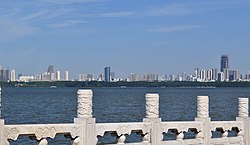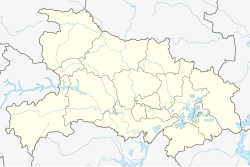Wuchangis one of 13 urbandistrictsof theprefecture-level cityofWuhan,the capital ofHubei Province,China.It is the oldest of the three cities that merged into modern-day Wuhan, and stood on the right (southeastern) bank of theYangtzeRiver, opposite the mouth of theHan River.The two other cities,HanyangandHankou,were on the left (northwestern) bank, separated from each other by the Han River.
Wuchang
Võ xương khu Wu-Chang | ||||||||||||||||||||||||||||||||||||
|---|---|---|---|---|---|---|---|---|---|---|---|---|---|---|---|---|---|---|---|---|---|---|---|---|---|---|---|---|---|---|---|---|---|---|---|---|
 East Lake overlooking Wuchang | ||||||||||||||||||||||||||||||||||||
 | ||||||||||||||||||||||||||||||||||||
| Coordinates:30°33′43″N114°20′25″E/ 30.5619°N 114.3404°E[1] | ||||||||||||||||||||||||||||||||||||
| Country | People's Republic of China | |||||||||||||||||||||||||||||||||||
| Province | Hubei | |||||||||||||||||||||||||||||||||||
| Sub-provincial city | Wuhan | |||||||||||||||||||||||||||||||||||
| Area | ||||||||||||||||||||||||||||||||||||
| • Total | 87.42 km2(33.75 sq mi) | |||||||||||||||||||||||||||||||||||
| Population (2010)[3] | ||||||||||||||||||||||||||||||||||||
| • Total | 1,199,127 | |||||||||||||||||||||||||||||||||||
| • Density | 13,717/km2(35,530/sq mi) | |||||||||||||||||||||||||||||||||||
| Time zone | UTC+8(China Standard) | |||||||||||||||||||||||||||||||||||
| Wuhan district map |
| |||||||||||||||||||||||||||||||||||
| Website | Võ xương khu chính phủ môn hộ võng trạm (translation: Wuchang District Government Web Portal(in Simplified Chinese) | |||||||||||||||||||||||||||||||||||
| Wuchang, Wuhan | |||||||||
|---|---|---|---|---|---|---|---|---|---|
 Changchun Temple | |||||||||
| Traditional Chinese | Võ xương | ||||||||
| |||||||||
The name "Wuchang" remains in common use for the part of urban Wuhan south of the Yangtze River. Administratively, however, it is split between several districts of the City of Wuhan. The historic center of Wuchang lies within the modern Wuchang District, which has an area of 82.4 square kilometres (31.8 sq mi) and a population of 1,003,400.[4]Other parts of what is colloquially known as Wuchang are withinHongshan District(south and south-east) andQingshan District(north-east). Presently, on the right bank of the Yangtze, it borders the districts of Qingshan (for a very small section) to the northeast and Hongshan to the east and south; on the opposite bank it bordersJiang'an,JianghanandHanyang.
On 10 October 1911, theNew Armystationed in the city started theWuchang Uprising,a turning point of theXinhai Revolutionthat overthrew theQing dynastyand established theRepublic of China.
History
editThe old Wuchang county
editIn 221, warlordSun Quanmoved the capital ofEastern WufromGong'ancounty,Jingzhou(northwest of present-day Gong'an county, Hubei) toÈcounty (in present-dayEzhouCity), and renamed È to Wuchang (literallyprospering from military,regarding itslogisticsrole of themilitary basesestablished before theBattle of Red Cliffs). Later in the yearCao Piproclaimed himself the emperor ofCao Wei.[citation needed]Sun Quan declared independence in the following year, and started to build forts and palaces in Wuchang. Sun Quan proclaimed himself the emperor of Eastern Wu in 229, and moved the capital toJianye.Sun Hao,the emperor of Eastern Wu between 264 and 280, moved the capital back to Wuchang in 265. In 589, the Wuchangcommanderywas abolished and the Wuchang county was transferred to a new commandery named Ezhou (headquartered in present-day Wuchang District), and remained in the administration since then.
The present day Wuchang town
editThe Wuchangcommanderywas set up when È was renamed to Wuchang, and included six counties. In 223 the commandery was renamed toJiangxia,and the capital of the commandery moved to Xiakou (in present-day Wuchang town). The name of the town was switched back and forth between Wuchang and Jiangxia several times in the following centuries. The present-day version ofWuying Pagoda,the oldest standing architecture in Hubei Province, was built around the time of fall of the Southern Song Dynasty. After 1301, the Wuchangprefecture,headquartered in the town, became the capital ofHubeiprovince.
During theTaiping Rebellion,Wuchang and the surrounding area changed hands several times after the Taiping capture of the city in theBattle of Wuchang(1852).
At the end of theQingEmpire, the Wuchang Prefecture (Võ xươngPhủ,then transcribed as 'Ou-tchang-fou') was the capital of the combined provinces ofHubeiandHunan,called the 'two Hu' orHuguang Viceroyalty.It was the seat of the provincial government of Huguang, at the head of which was aviceroy of Huguang.Next toNanjingandGuangzhou,it was one of the most important vice-royalties in the empire.[citation needed]
It possessed an arsenal and a mint. The provincial government establishedironworksfor the manufacture of rails and otherrailwaymaterial. As the works did not pay under official management, they were transferred to the director-general of railways. Wuchang was not open to foreign trade and residence, but a considerable number ofmissionaries,bothRoman CatholicandProtestant,lived within the walls. The native population was estimated at 800,000 around 1911, including cities on both banks. At that time, Wuchang was an important junction on the trunk railway fromBeijingto Guangzhou; and was on the route of theSichuanrailway.
In Wuchang on October 10, 1911, a revolt broke out against the Qing Dynasty. This event, now called theWuchang Uprisingand celebrated asDouble Ten Day,was the catalyst that started theXinhai Revolution,which led to the development of theRepublic of China.
In 1912, the Wuchang prefecture was abolished and a new Wuchang county (just next to the Wuchang county in the Ezhou city) was created. In 1926 the Wuchang town was promoted to a city, and merged withHankouandHanyangto form a new city namedWuhan.
After 1949, the more urban part of the Wuchang County was absorbed into the new Wuhan City and was administratively partitioned into Wuchang,QingshanandHongshandistricts, while the remaining, mostly rural, southern part retained the name of Wuchang County. In 1995, Wuchang County becameJiangxia Districtof Wuhan.
Geography
editAdministrative divisions
editWuchang District administers:[5][6][7]
Notable people
edit- SaintFrancis Regis Clet,one of theMartyr Saints of China,executed in Wuchang in 1840
- Li Bingbing,actress and singer
- Jayne Meadows,American stage, film and television actress
See also
editThe Wuchang fish (Megalobrama amblycephala;Võ xương ngư;Võ xương ngư;Wǔchāng yú) is named after the town.
References
edit- ^"Wuchang"(Map).Google Maps.Retrieved2014-07-02.
- ^"Wuhan Statistical Yearbook 2010"(PDF).Wuhan Statistics Bureau. p. 15.Retrieved2011-07-30.
- ^Võ hán thị 2010 niên đệ lục thứ toàn quốc nhân khẩu phổ tra chủ yếu sổ cư công báo(in Simplified Chinese). Wuhan Statistics Bureau. 2011-05-11. Archived fromthe originalon 2011-10-25.Retrieved 2011-06-11.
- ^"Profile of Wuchang District"(in Chinese). official website of Wuchang District Government. Archived fromthe originalon 2008-03-24.Retrieved2008-04-19.
- ^Võ hán thị võ xương khu khu chúc bộ môn dự quyết toán cập “Tam công” kinh phí dự quyết toán tín tức(in Simplified Chinese). Wuchang District People's Government.Retrieved27 December2017.
Thạch động nhai dương viên nhai từ gia bằng nhai tích ngọc kiều nhai trung hoa lộ nhai lương đạo nhai hoàng hạc lâu nhai tử dương nhai bạch sa châu nhai thủ nghĩa lộ nhai trung nam lộ nhai thủy quả hồ nhai lạc già sơn nhai nam hồ nhai
- ^Võ xương khu lịch sử duyên cách[Historical Development of Wuchang District] (in Simplified Chinese). XZQH.org. 7 July 2014.Retrieved27 December2017.
2010 niên đệ lục thứ nhân khẩu phổ tra, võ xương khu thường trụ tổng nhân khẩu 1214287 nhân, kỳ trung: Tích ngọc kiều nhai đạo 60323 nhân, dương viên nhai đạo 109485 nhân, từ gia bằng nhai đạo 123918 nhân, lương đạo nhai đạo 64704 nhân, trung hoa lộ nhai đạo 44262 nhân, hoàng hạc lâu nhai đạo 60909 nhân, tử dương nhai đạo 61135 nhân, bạch sa châu nhai đạo 76226 nhân, thủ nghĩa lộ nhai đạo 69562 nhân, trung nam lộ nhai đạo 216216 nhân, thủy quả hồ nhai đạo 178628 nhân, lạc già sơn nhai đạo 75128 nhân, thạch động nhai đạo 6664 nhân, nam hồ nhai đạo 52596 nhân, đông hồ phong cảnh khu nhai đạo ( võ xương ) 14531 nhân.
- ^2017 niên thống kế dụng khu hoa đại mã hòa thành hương hoa phân đại mã: Võ xương khu[2017 Statistical Area Numbers and Rural-Urban Area Numbers: Wuchang District].National Bureau of Statistics of the People's Republic of China.2017.Retrieved20 October2018.
Thống kế dụng khu hoa đại mã danh xưng 420106001000 tích ngọc kiều nhai bạn sự xử 420106002000 dương viên nhai bạn sự xử 420106003000 từ gia bằng nhai bạn sự xử 420106005000 lương đạo nhai bạn sự xử 420106006000 trung hoa lộ nhai bạn sự xử 420106007000 hoàng hạc lâu nhai bạn sự xử 420106008000 tử dương nhai bạn sự xử 420106009000 bạch sa châu nhai bạn sự xử 420106010000 thủ nghĩa lộ nhai bạn sự xử 420106011000 trung nam lộ nhai bạn sự xử 420106012000 thủy quả hồ nhai bạn sự xử 420106013000 lạc già sơn nhai bạn sự xử 420106014000 thạch động nhai bạn sự xử 420106015000 nam hồ nhai bạn sự xử 420106490000 đông hồ phong cảnh khu nhai đạo ( võ xương )

